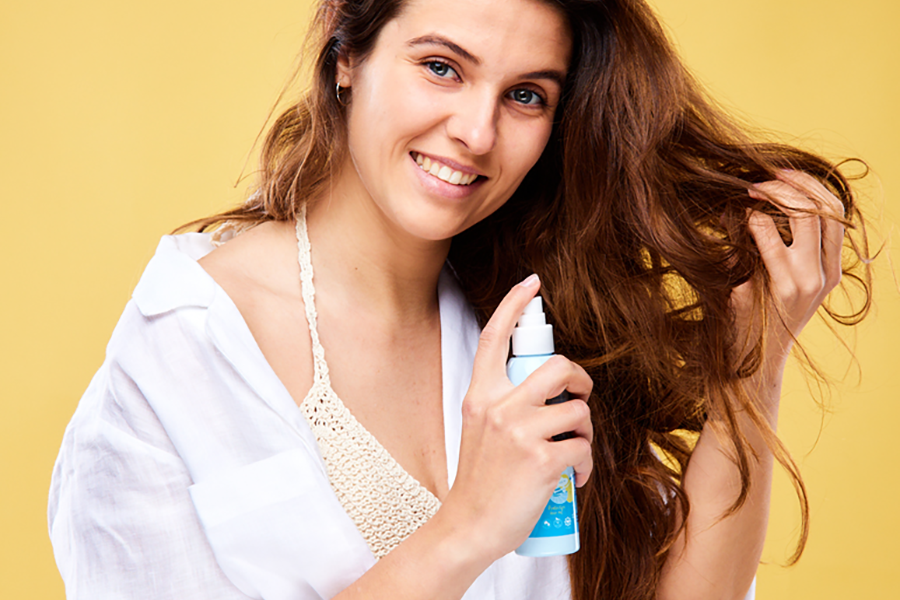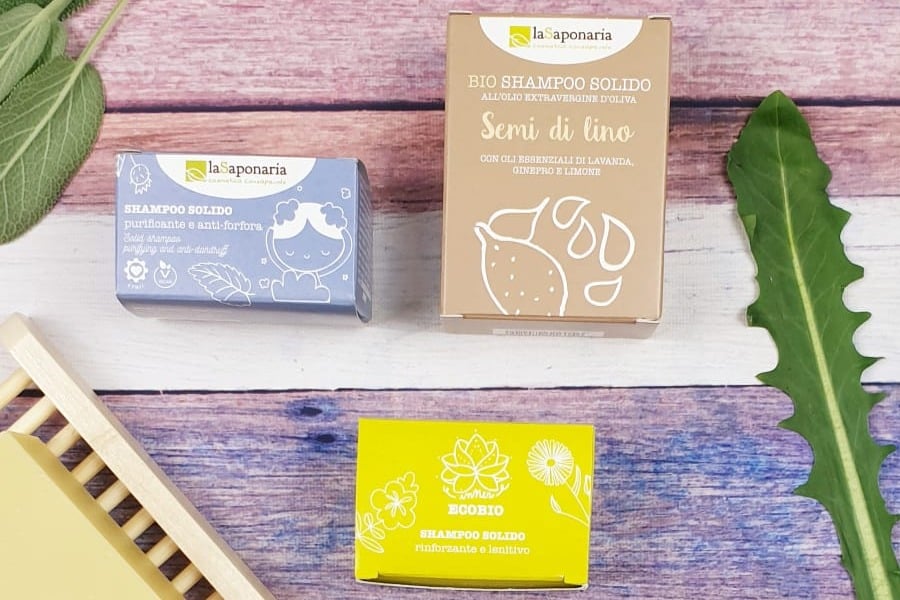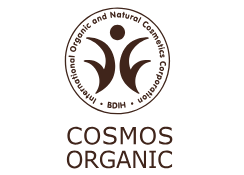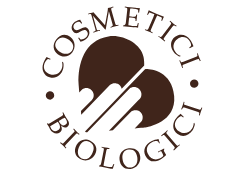Taking care of your hair with organic products is a great way to maintain healthy hair. Discover how to start a natural hair routine.
Understanding the scalp and its role is the first step in caring for your hair. This helps avoid neglecting the scalp and prevents hair issues from developing.
If you want to repair visibly stressed hair, making a sustainable choice not only benefits the planet but also strengthens your hair from root to tip—especially if your scalp has been damaged by bad habits or prolonged use of harsh products.
By setting up a hair routine tailored to your hair type, it’s possible to nourish and fortify the scalp, resulting in soft, shiny hair—a sign of natural well-being.
In this content, we will explore the topic of hair care in detail, specifically:
How to identify your hair type
Hair is made of protein filaments that grow from follicles located within the scalp.
They play an important role both from a protective and aesthetic point of view. To take care of them properly, it is essential to understand their structure and identify your hair type, so you can choose the most suitable organic products for your needs. If you’re unsure about your hair type, you can always take our test!

Vediamo insieme l’importanza che ricopre il cuoio capelluto nel benessere dei capelli per poi analizzare gli elementi fondamentali di cui si compongono.
The importance of the scalp
The scalp is the area of the skin where hair originates and grows. Its function is to protect the head through thermoregulation, shielding it from the heat of the sun’s rays and from intense cold.
The scalp is especially important because it nourishes the hair, thanks to the dense network of capillaries and sebaceous glands beneath it.
Very often, the causes of dry, oily, dull, fragile or overly thick hair can be traced back to the scalp. Therefore, to understand how to address issues involving the skin of the head, it is essential know the different scalp types.
Normal scalp
A scalp is considered normal when, physiologically, it functions properly! This means that dead cells are expelled from the surface of the hair through the natural desquamation process, making way for new keratinocytes — all this happening imperceptibly, without discomfort or itching.
Having a normal scalp doesn’t mean you shouldn’t support your hair with some extra nourishment. On the contrary, it is advisable to use specific organic products, such as our hydrating lotion and the Energia solid shampoo, to make the hair fuller and shinier.
Sensitive scalp
The scalp is naturally a very sensitive area due to the many receptors present in the subcutaneous layer. In some cases, this sensitivity is heightened by strong reactions to pollutants, stress, or overly harsh hair products, causing both invisible issues such as burning sensations and visible ones such as dry dandruff or, in more severe cases, seborrheic dermatitis.
This condition does not prevent you from having healthy hair or enjoying creative styling. There are highly specific natural products designed for the most delicate skin types, such as the Extravirgin Organic Shampoo, which helps soothe all the discomfort caused by a sensitive and irritated scalp.
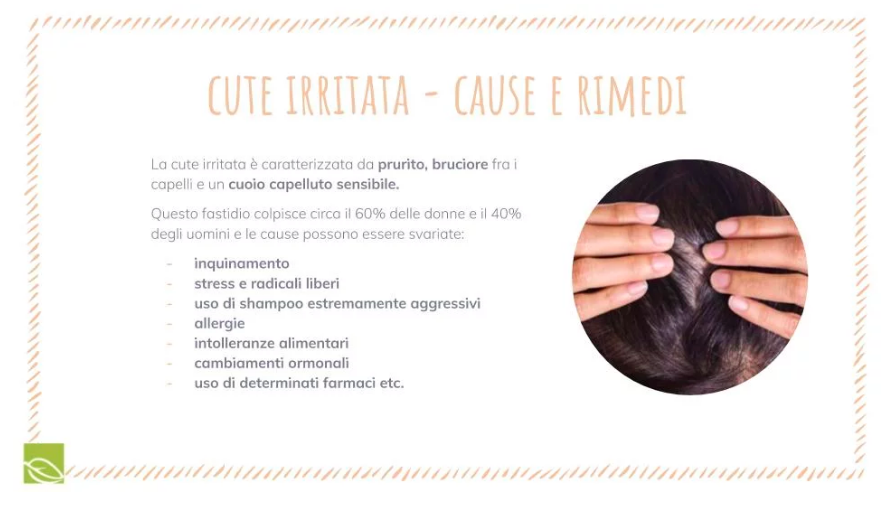
Dry scalp
A dry scalp appears through the lifting and detachment of the skin’s corneous layers, known as dry dandruff. This can cause intense itching and, in more severe cases, skin infections and hair loss.
This excessive flaking is often triggered by frequent washing, the type of shampoo used, and also by how the hair is rinsed and dried. For this reason, the most suitable specific product is the Soothing and Moisturizing Hair Lotion: it contains chicory prebiotic, which strengthens the skin’s natural microbiota by restoring balance to sensitive scalps and improving resistance to external irritants.
To effectively counteract scalp dryness, it is essential to be gentle. Avoid rubbing instead, massage the skin, keep the hairdryer at least 10 cm away while drying, or choose a gentle drying method by patting the hair with a cotton towel.
Oily scalp
When the hair becomes greasy quickly, the issue often originates in the scalp, stimulated to produce an excessive amount of sebum. In this case, the sebum deposits on the hair roots, creating an unsightly greasy layer that makes the hair look oily and itchy..
An oily scalp releases a larger amount of thick, whitish dandruff flakes due to increased cell turnover, a major discomfort for those who experience it.
To care for oily hair, it is important to rely on natural remedies, such as the Detox Anti-Dandruff Scalp Lotion, which directly targets the root of the issue and helps restore the hair’s natural beauty.
How many hair types are there?
Based on genetic factors, many different hair types can be identified, each with its own strengths and weaknesses.
To determine your hair type, it is necessary to understand the common factors and the elements that differentiate them.
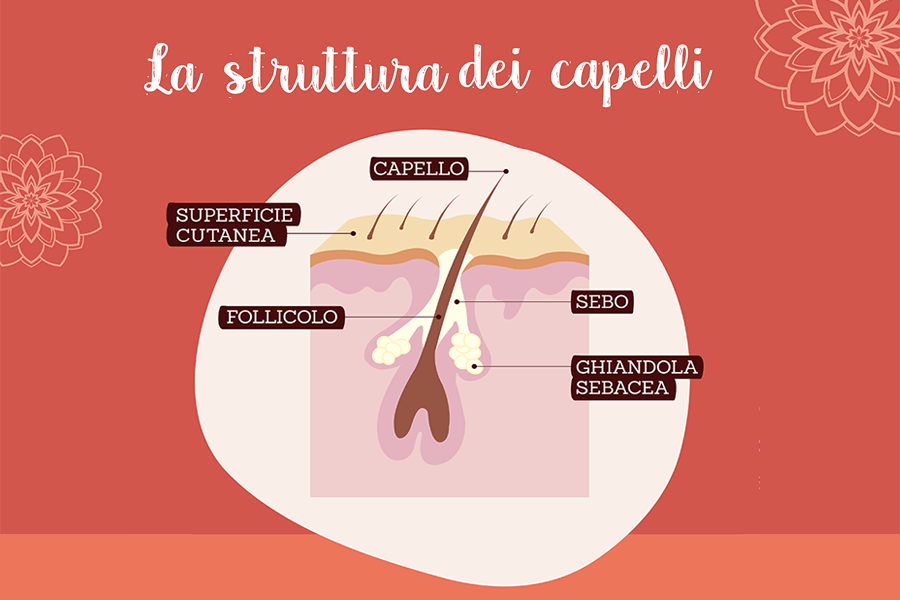
Internal structure of the hair
Looking at a horizontal cross-section of a hair, we can observe three main concentric areas:
- Cuticle: the outermost part of the hair, made up of a single row of thin cells (0.25 microns thick) arranged vertically near the root and in oblique, scale-like layers along the shaft. Because of its position, the cuticle is the first part to be damaged when hair is mistreated.
- Cortex: the intermediate area and the largest part of the hair. It is composed of elongated cells arranged in parallel rows. Unlike the cuticle, the cortex contains pigment, melanin, which decreases over time, leading to the greying process.
- Medulla: the innermost part of the hair, formed by rounded cells arranged in columns and separated by air pockets. These help protect the hair from extreme temperatures and maintain balanced internal hydration.
These three parts are common to all hair types. What varies is the organic composition the amount of lipids, minerals, and pigments that define each hair type.
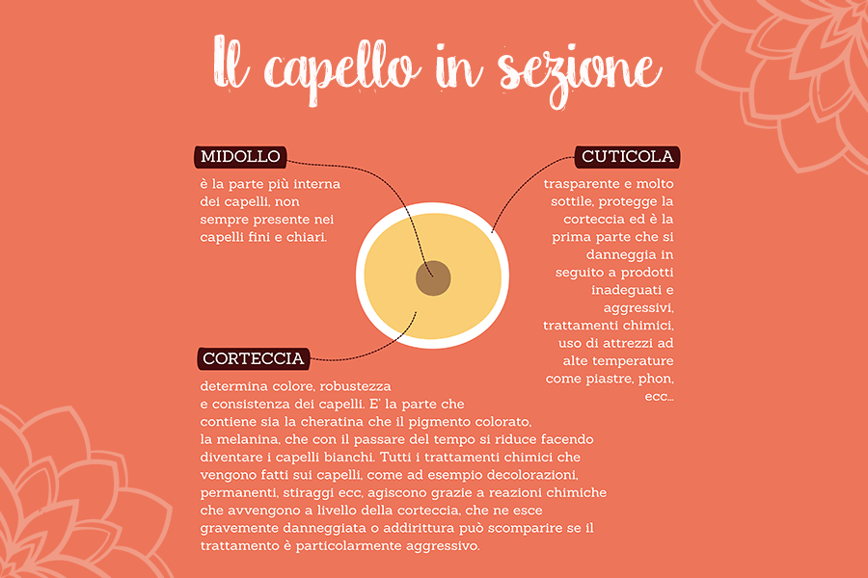
Organic composition of the hair
Hair is made of 95% fibrous proteins called keratins, while the remaining percentage is composed of lipids, minerals, and pigments.
A deficiency in any of these components can lead to structural problems, such as fine or fragile hair.
- Keratin: A sulfur-rich, water-insoluble filamentous protein. Hair contains alpha and beta keratins, made up of essential amino acids. Keratin provides elasticity, strength, and resistance, especially in the cortex. Its production is influenced by genetics but also by poor habits such as: an unbalanced diet high in fats and low in minerals, pollution, prolonged sun exposure, and harsh cosmetic treatments. Maintaining a healthy lifestyle and proper hair care helps preserve keratin levels over time.
- Melanin: The pigment responsible for hair color, produced by melanocytes also found in the skin. There are two types:
- Eumelanin gives black and brown tones
- Feomelanina gives blonde and red tones, with age, melanocytes reduce pigment production, causing grey hair. In some cases, this occurs prematurely due to genetic or medical conditions.
- Lipids: These come exclusively from sebum produced by sebaceous glands in the scalp. Main sebum components include squalene, triglycerides, wax esters, sterol esters, and cholesterol. Lipids lubricate and protect both the hair and scalp by forming a hydrolipidic film. Sebum production varies depending on overall health, external environment, or stress caused by frequent washing or stimulating hair products. It is important to use shampoo that respects the natural skin pH (5–5.5) and avoid harsh detergents that strip the hair of its natural protection, prompting it to produce even more sebum in an attempt to restore the hydrolipidic balance.
- Minerals: Also known as trace elements, these nutrients are essential for the health of skin and hair. They reach the hair through blood circulation in the scalp. Sometimes diet alone isn’t enough, so natural supplements can help maintain healthy hair. Nourishing hair masks can also replenish and revive dull or dehydrated hair.
With this overview of hair structure and composition complete, we can now explore the different hair types. What determines the hair shape (straight, curly or wavy) depends on the angle of the hair follicle and the amount of keratin within it.
Straight hair
Straight hair (lissotrichous) has a round follicle and emerges from the scalp at a 90-degree angle, resulting in a smooth, movement-free appearance.
Two categories exist:
- Fine straight hair: easy to manage but lacking volume; struggles to hold waves and gets greasy quickly, especially at the roots.
- Thick straight hair: less prone to flyaways and maintains shape better, but tends to become frizzy in humid conditions.
To keep straight hair healthy, respect its density. Fine hair, for example, should not be exposed to very high temperatures.
Using a detangling conditioner for straight hair such as the Organic Lemon Volumizing Conditioner, helps maintain styling and provides extra care.

Wavy hair
Wavy hair (cymotrichous) has an oval-shaped follicle with a greater inclination. These hair types contain more keratin, creating stable sulfur bonds responsible for the waves.
Because of their structure, they are very versatile for both curly and straight styling, have good volume, and get dirty more slowly. While wavy hair is loved for its versatility, it is also disliked for the puffiness it can develop in more humid conditions.
The best ally is doubtless the Crema Ravvivaricci, a modelling treatment that shapes waves while fighting frizz and strengthening unruly hair, thanks to chicory prebiotic and aloe gel for deep hydration and shine.
Curly hair
Curly hair is formed by follicles angled strongly diagonally, creating a more oval cross-section and irregular keratin distribution. This uneven pattern produces the characteristic tight curls.
This hair type is prone to frizz, often becoming straw-like. To eliminate frizz, start in the shower: detangle well and use a Leave-in Anti-Frizz Conditioner so it can penetrate the hair fiber and control frizz during drying.

After identifying your hair type, you can choose the most suitable natural products. If you’re unsure or want deeper insights, a tailored hair-type test can help.
Scalp issues and the most effective remedies
This section explains the most common hair and scalp problems, how to recognize them, and how to treat them using organic cosmetics; of course, these issues depend on age, genetic predisposition, and lack of proper care, so early attention and prevention are key.
How to fight dandruff?
Dandruff is a discomfort that affect the scalp and it is more common than one might think. This issue results from increased skin cell turnover: once dead cells reach the epidermis, they die detaching through the desquamation, as white flakes, identified as dandruff.
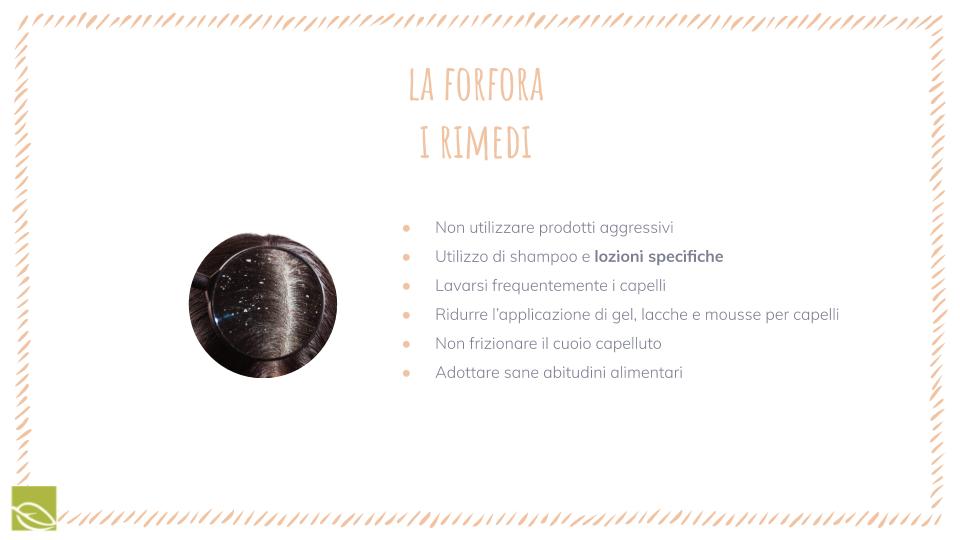
It causes both cosmetic and physical discomfort, including mild to intense itching linked to several factors:
- Oily skin: yellowish, thick scales form due to the high amount of sebum. This condition is generally associated with seborrheic dermatitis affecting the scalp. This type of dandruff tends to remain attached to the hair and is caused by genetic predisposition, endocrine hormonal imbalances, stress, or fungal proliferation.
- Dry skin: easy to recognize by its light, white flakes that fall onto the shoulders. Dry dandruff is caused by insufficient hydration of the scalp, which accelerates desquamation, as well as by the use of harsh cleansers, washing with water that is too hot, or a weakening of the immune system.
- Skin conditions: an example is psoriasis, which causes inflammation of the scalp and the production of large, itchy scales. In this case, there are no definitive solutions; it is necessary to consult a dermatologist who can investigate the causes and appropriate treatments.
It is possible to improve this condition by addressing the first two factors described—oily and dry skin—through the use of targeted scalp treatments. One example is the Detox Anti-Dandruff Scalp Lotion. The prebiotics contained in this lotion strengthen the skin’s natural microbiota and its community of beneficial bacteria, helping restore the scalp’s balance. They also play a crucial role in regulating sebum, which, when imbalanced, can lead to itching and dandruff.
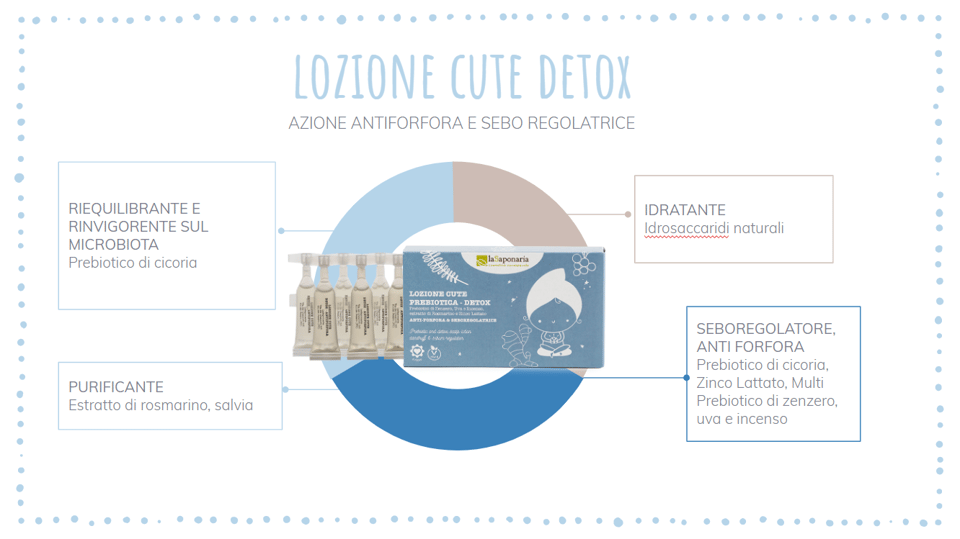
The effect of the lotion is enhanced by chicory prebiotic, which helps reduce sebum production, and by sage and rosemary extracts, known for their strong purifying action.
It is useful for: purifying the scalp, preventing and reducing dandruff, soothing and hydrating the skin, and treating oily dandruff.
It is also advisable to avoid frequent washing with very hot water and to pay attention to diets high in saturated or hydrogenated fats, which may lead to excess sebum on the scalp. Finally, never underestimate the condition of the immune system, which plays an active role in fighting infections or dermatological issues and in speeding up skin repair.
How to cover grey hair with natural products?
Graying is the physiological process that leads to the appearance of white hair, a concern shared by all hair types. Sooner or later, many silver strands will appear, and they do not always correlate with aging!
In fact, multiple factors can accelerate the graying process:
- A diet low in vitamins and minerals, particularly copper deficiency
-
Unhealthy habits such as smoking, excessive alcohol consumption, or misuse of medication
-
Hormonal imbalances that can interfere with melanin production
-
Periods of high stress that cause nutritional imbalances
-
Pathological conditions such as vitiligo or thyroid disorders
To prevent the early appearance of white hair, it is important to pay attention to all these factors: in addition to avoiding smoking and stress, you can incorporate copper-rich, vitamin-rich, and mineral-rich foods into your diet, and rely on targeted dietary supplements.
Those who already have visible white hair can opt for hair dyes — even better if they are natural! These not only cover white strands but also act as a true wellness booster for the hair. They release the right amount of pigment without ammonia, chemical additives, hydrogen peroxide, or formaldehyde, thanks to the presence of herbal colorants or henna, which make the product completely organic and eco-friendly.
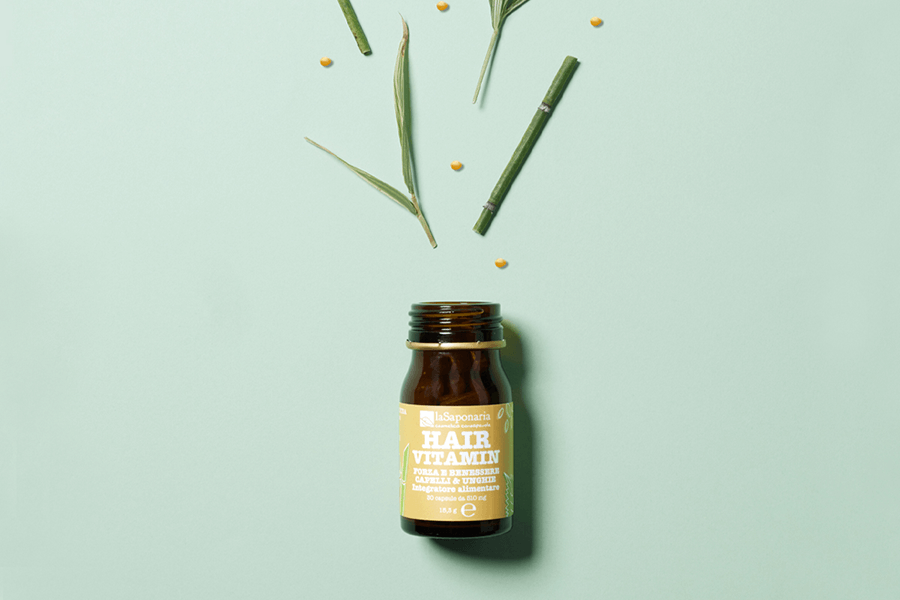
How to combat hair loss?
Hair loss is a physiological process common to everyone; in fact, we lose between 50 and 100 hairs every day. However, when this loss is not compensated by the regrowth of new hair from the follicle, it becomes a real issue, one that affects a large portion of the population.
An early warning sign that may call for preventive treatments is excessive shedding during unexpected periods, that is, outside seasonal changes or highly stressful situations. Still, before trying DIY remedies, it’s always best to undergo a medical check-up to ensure it is indeed true hair loss.
The causes behind this phenomenon include:
- Genetics, especially in men (you can read the dedicated article)
- Vitamin A and Zinc deficiency: dietary supplements, such as those with Biotin and rich in Vitamin A and Zinc; can be beneficial
- Unbalanced diet: in this case too, taking a targeted dietary supplement is a great way to keep the hair strong and healthy and reduce excessive shedding
- Hormonal changes, such as menopause or pregnancy
- Aggressive cosmetic treatments
- Stress
Hair is a truly important part of who we are, and it deserves to be protected with natural methods!
And when genetics play the leading role, the best strategy is to take action early with a mix of natural extracts—like those found in the Hair Plus Complex, a powerful, fully natural phytocomplex that works directly on the hair bulb, increasing its size and strengthening the hair.
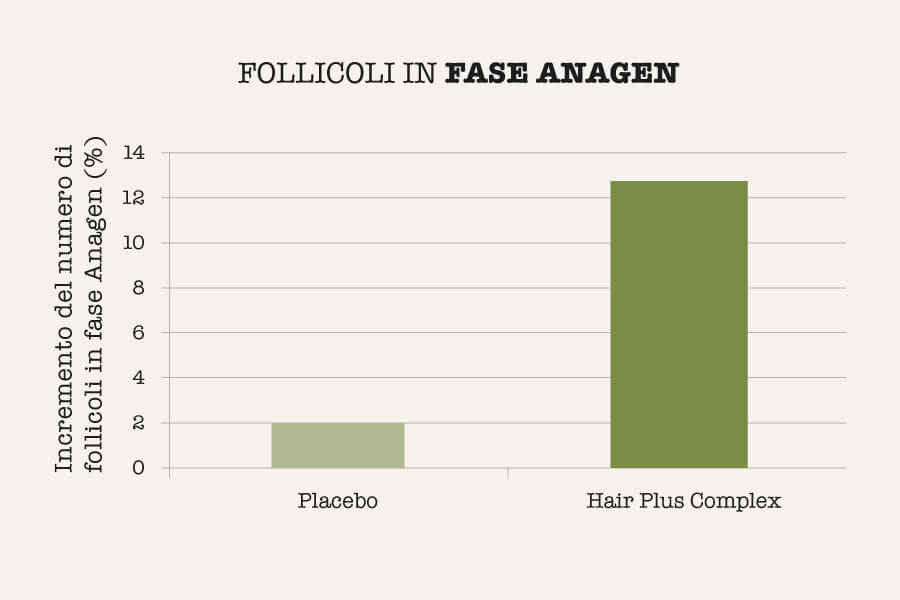
For clarifications, personalized advice or natural remedies to address specific hair concerns, a consultation is exactly what you need! A small tip to improve hair health: build a natural routine capable of restoring strength and shine to weakened hair or hair experiencing more serious issues. Below, we’ll explore where to start.
Natural hair routine for Healthy hair
If you dream of beautiful hair, any random shampoo and conditioner won’t do the job! There are steps that must be followed carefully, and once learned, they will easily become part of your weekly hair routine.
Below you’ll find the essential steps, which should then be adapted according to your hair type.
Step 1- Choose the Right Shampoo
Choosing the right shampoo for your hair type is not as simple as it seems. Several factors need to be considered, such as:
- Hair length
- Fiber thickness
- Hair type (straight, wavy or curly)
- Any specific concerns or needs, such as color-treated hair
To focus on scalp health, it’s important to provide the right amount of nutrients—no more, no less. Using a shampoo that doesn’t meet the scalp’s needs may lead to issues such as excess sebum production or even dermatitis.
Before buying a shampoo, it’s essential to know how to read the label and understand which ingredients it contains: avoid formulas with harsh surfactants or chemical stabilizers, and opt instead for products that respect the skin’s natural pH and include organic ingredients.
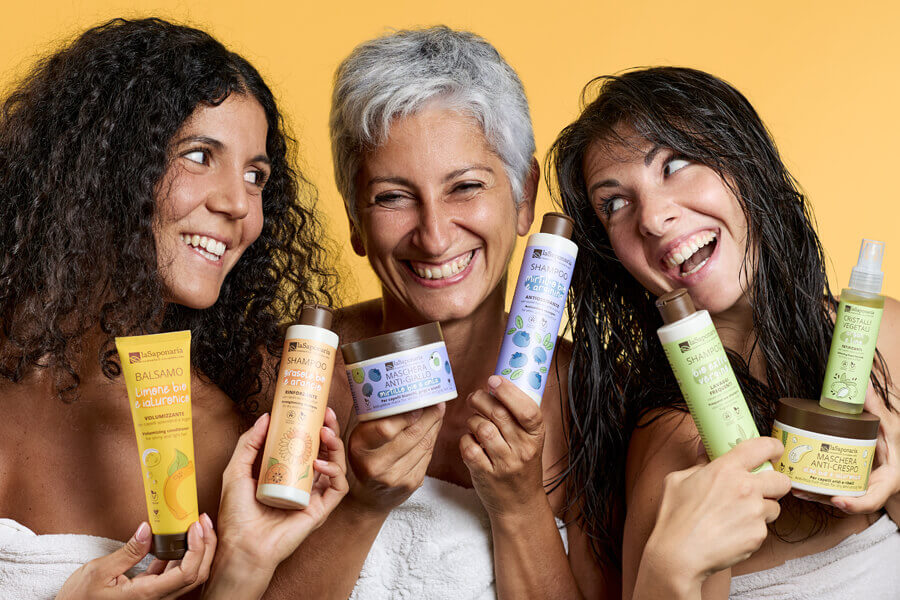
Step 2- Nourish your hair without wheighing it down
Once you’ve applied and rinsed the right shampoo, it’s time to nourish your hair, but how?
Conditioner is certainly useful for detangling and providing a light level of nourishment. However, if you want to boost strength and vitality, you should complement your conditioner with hair masks once or twice a week, depending on your hair’s needs.
Here too, the same factors considered when choosing your shampoo apply. However, you can also evaluate what your hair needs in that specific moment by paying attention to how it looks and feels. If your hair appears dull, dry, flat, or damaged, choose a targeted organic treatment designed to restore and strengthen its structure.
Step 3- Wait the recommended processing time
Whether you’re applying a mask, a conditioner, or a hair color treatment, allowing the proper processing time is essential for the product to work evenly along the entire length of the hair.
During this waiting period, typically 5 to 10 minutes for masks, while hair colors require checking the instructions on the packaging, it’s good practice to gently massage your hair, starting from the ends and working your way toward the scalp. This helps the product penetrate deeply, delivering concentrated nourishment and beauty.

Step 4- Remove all the product from the scalp
Removing every trace of product used during cleansing will ensure better styling hold and prevent hair from becoming greasy again just a few hours after washing.
A useful tip to make sure you rinse out all residues of shampoo, conditioner or mask is to use a fine-toothed comb under running water. Passing it through your hair not only helps eliminate any remaining knots but also removes the last traces of product, leaving your hair light and clean.
Step 5- Protect the cuticles from high temperatures and dry stressfull
High temperatures can be very damaging to hair, especially when it’s wet, as water dilates the fiber and makes it more fragile.
To avoid this, after washing your hair, wrap it in a soft, clean towel to gently absorb excess water. Next, apply a nourishing and protective oil to help define the style and add shine. Be careful if you have fine hair, the risk is weighing it down and making it look greasy. For thick, wavy or curly hair, however, nourishing oils are ideal as they help with hydration and definition. Then proceed with drying, keeping the hairdryer on the lowest airflow and on a medium temperature. With this method, your hair will be light, shiny and soft, as it dries without any thermal stress.
Healthy hair starts with a well-designed hair routine that includes natural scalp-cleansing products free from parabens, capable of respecting both the scalp’s pH and the hair’s natural structure.
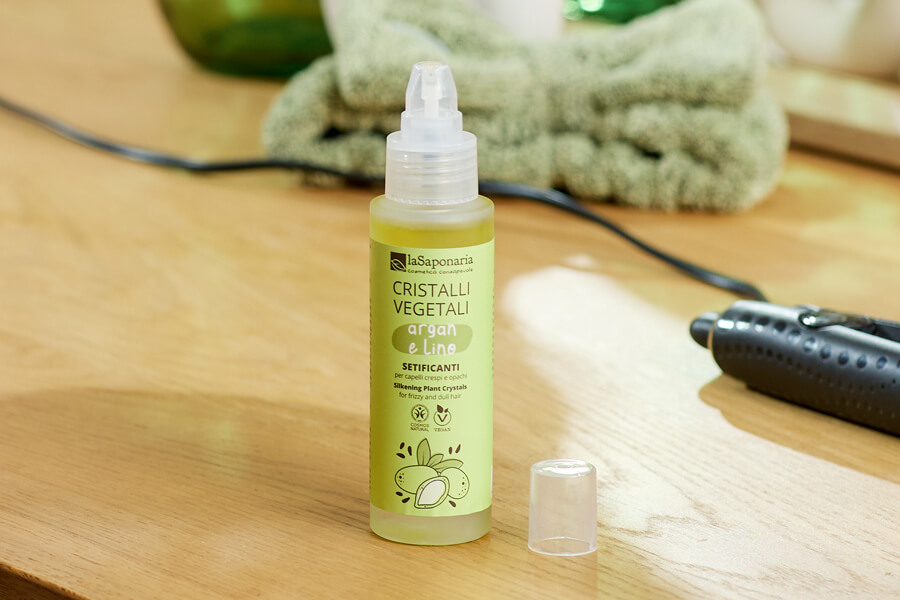
Taking care of your Hair with natural products: all the benefits
In everyday life, our hair is constantly put to the test by an increasingly hectic routine: city pollution, workouts, and frequent styling all place significant stress on the scalp. That’s why it’s important to remember that hair, just like skin, needs to be pampered, and the best way to do so is by embracing organic and natural cosmetics.
The advantage of choosing organic haircare lies not only in doing something good for the planet, but also in protecting the hair fiber. Many conventional products coat and seal damaged cuticles with synthetic substances such as silicones, creating a fake “healthy hair” effect that is purely cosmetic and not truly beneficial.
Products formulated with natural ingredients, on the other hand, provide real nourishment and hydration. Thanks to their affinity with the hair’s natural structure, they can reach the cortex and medulla, helping the cuticles recompact and close naturally.
Over time, and with a complete switch to natural products, you’ll notice softer, shinier hair, a true sign of scalp wellbeing.
Solid Shampoo and Conditioner: what they are and how to use them
More and more people are choosing solid shampoos and conditioners.
Which are the benefits of using this amazing product?
- The first thing you’ll notice is the practical, plastic-free packaging, easy to carry anywhere without bulk.
- They truly respect every type of scalp, remaining gentle even on the most sensitive skin.
- They rinse off easily without leaving residue on the hair, keeping it light and clean.
- They’re simple to use: just rub the bar between your hands like a soap to create a soft lather.
What can we say? Once you try them, you’ll never go back!
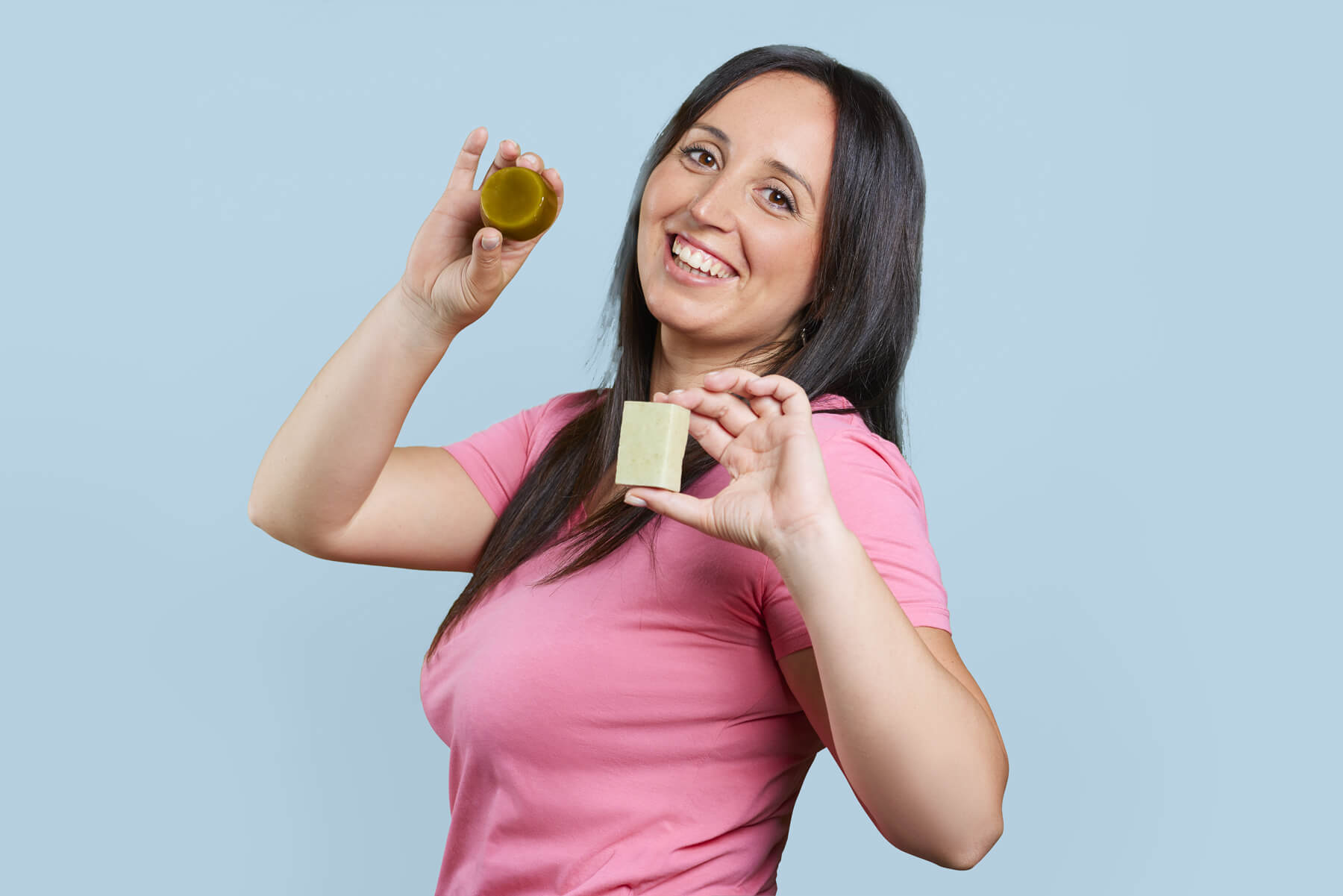
A new line of natural haircare products for children
When it comes to children, there’s no room for compromise. For their haircare, you must always choose products that respect their delicate skin and overall health.
By choosing eco-organic cosmetics for your little ones’ hair, you safeguard their wellbeing while also doing something good for the planet.
Children produce less sebum than adults, which makes their skin more vulnerable to the harsh agents often found in traditional bath foams and cleansers. What they truly need are products that protect and soothe naturally, without allergens or synthetic ingredients.
The Revolution of organic products for every hair type
The main reason to avoid hair products containing silicones and parabens is the effect they may have on the skin. These substances can trigger allergic reactions and, in more severe cases, contact dermatitis, not to mention their high environmental impact.
Sensitivity to silicones and parabens is becoming increasingly common and continues to rise. And while current regulations impose strict controls on these ingredients, why take the risk?
The real revolution lies in the emergence of organic haircare products that adapt perfectly to every skin type and every hair type, without compromising the health of the scalp or the wellbeing of our planet.


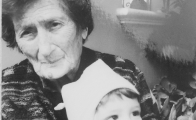

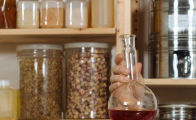
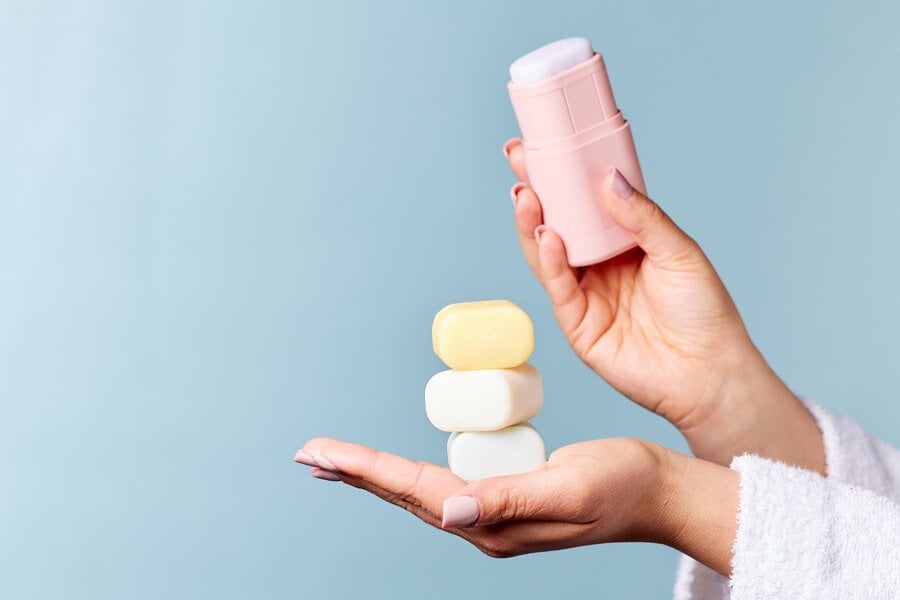
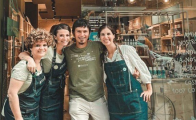

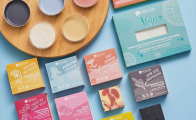

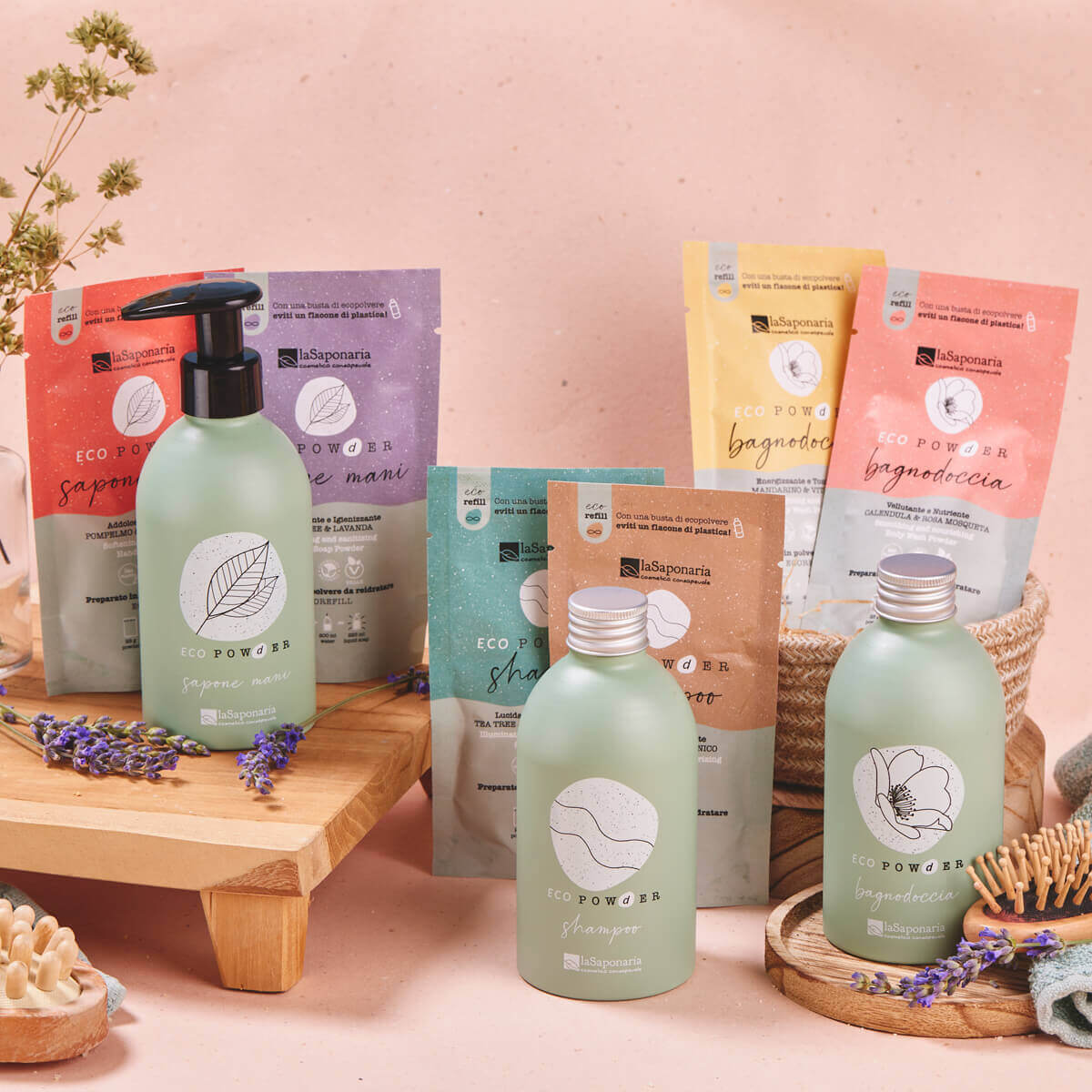
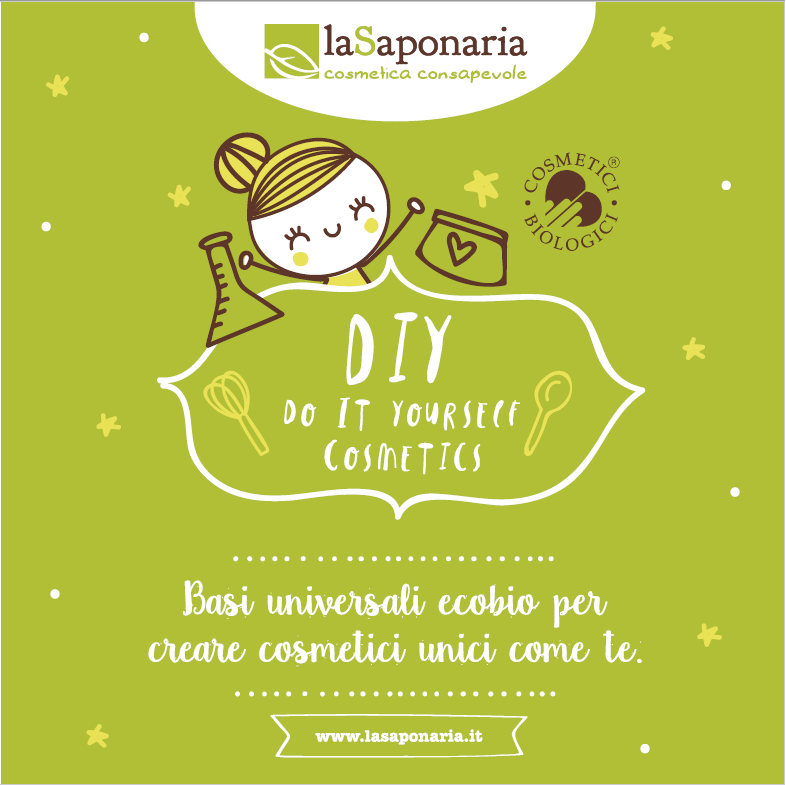


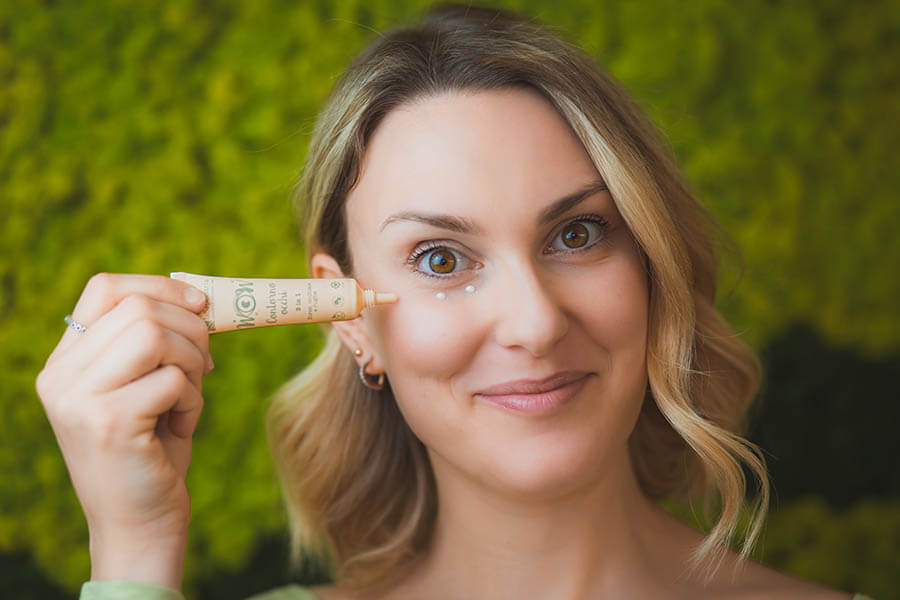



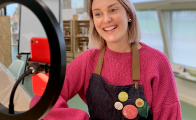

















.png)
